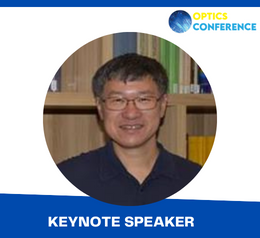Scholars 2nd Edition International Conference on
Optics, Lasers and Photonics
THEME: "A New Era towards Optics, Lasers & Photonics Technologies"
 27-28 Mar 2023
27-28 Mar 2023  Crowne Plaza Ealing, London, UK & Online
Crowne Plaza Ealing, London, UK & Online THEME: "A New Era towards Optics, Lasers & Photonics Technologies"
 27-28 Mar 2023
27-28 Mar 2023  Crowne Plaza Ealing, London, UK & Online
Crowne Plaza Ealing, London, UK & Online 
Xi'an Jiaotong University, China
Title: Highly dispersive vortex modes in optical fibers
Yang Yue received the Ph.D. degree in electrical
engineering from the University of Southern California, USA, in 2012. He is a
Professor with the School of Information and Communications Engineering, Xi'an
Jiaotong University, China. Dr. Yue’s current research interest is intelligent
photonics, including optical communications, optical perception, and optical
chip. He has published over 240 journal papers (including Science) and
conference proceedings with >10,000 citations, five edited books, two book
chapters, >60 issued or pending patents, >200 invited presentations
(including 1 tutorial, >30 plenary and >50 keynote talks). Dr. Yue is a
Fellow of SPIE, a Senior Member of IEEE and Optica. He is an Associate Editor
for IEEE Access and Frontiers in Physics, Editor Board Member for four other
scientific journals, Guest Editor for >10 journal special issues. He also
served as Chair or Committee Member for >100 international conferences,
Reviewer for >70 prestigious journals.
The demand on information
transmission capacity is exponentially increasing, which promotes the research
in high-capacity optical transmission systems. Space division multiplexing
(SDM) has attracted great interest because of its potential in dramatically increasing
the data capacity. The intrinsic orthogonality among orbital angular momentum
(OAM) modes with varied l contributes
to the theoretically infinite quantity of beams carrying OAM, which introduces
a new degree of freedom to SDM. Chromatic dispersion (CD) is one of the key
factors in optical systems, which is extensively used in time lens, microwave
photonics subsystems and true time-delay beam former. This talk presents the
dispersion characteristics of vortex modes supported in optical fibers.
Here, we introduce some specialty optical fibers
for supporting highly dispersive vortex modes. First, the basic concept and
applications of chromatic dispersion and vortex modes are briefly introduced.
Then, the structures and principle of the highly dispersive conventional fiber
for fundament mode and the double ring-core fiber for vortex modes are depicted
and compared. In order to visualize the coupling process, we present properties
of the OAM mode in the double ring-core fiber, including the effective refractive
index, effective mode area, ratio of power integral, chromatic dispersion, and
loss. The OAM1,1 mode supported in the designed coupled ring-core
fiber can achieve an extremely negative chromatic dispersion as low as -86,288
ps/(nm·km) at 1535.4 nm. Furthermore, the OAM130,1 mode supported in
the Schott glass coupled ring-core fiber has a large negative chromatic
dispersion of -20,271 ps/(nm·km) at 1260.4 nm. The photonic crystal fiber and
triple ring-core fiber, which share the same principle with the dual-ring
fiber, are also briefly introduced as supplementary. We believe the highly
dispersive optical fiber for OAM modes may find more promising applications in
fiber-optic OAM systems.